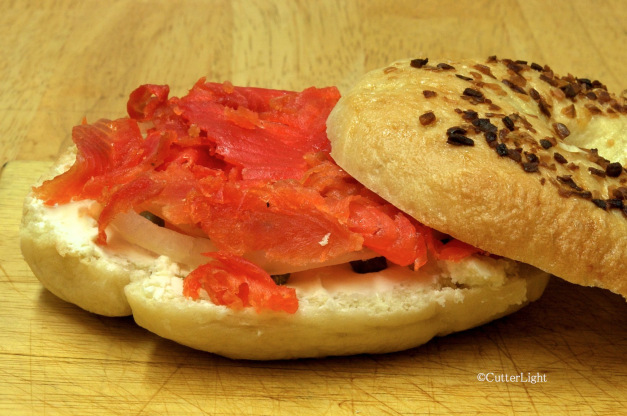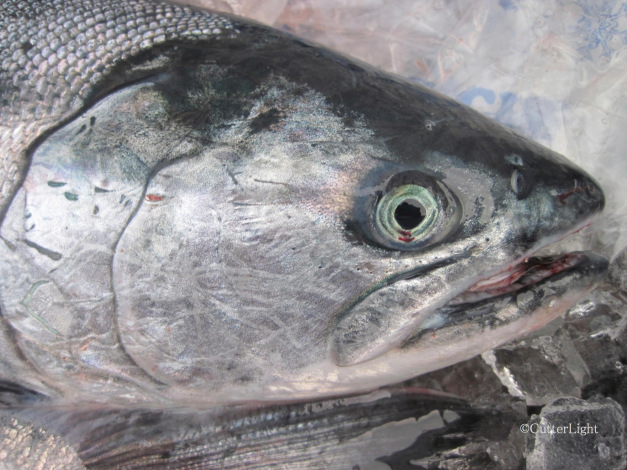With a history dating back to the European Middle Ages, a number of methods for preparing lox and gravlax (or gravad lax) have evolved. We’ve settled on a dry-brining method that produces beautifully colored, deliciously flavored salmon fillets ready to be sliced translucently thin as on the above freshly made onion bagel.
Many cultures have a tradition of salting and burying fish, a technique that results in both preservation and fermentation. In fact, the origins of sushi can be traced back to fish prepared in this method. The grav of gravlax derives from the Scandinavian word for grave, and lax, salmon, has cognates in many old European languages. Thus gravlax literally means “buried salmon.”
Although preparing lox is somewhat labor intensive (the fillets are packed in salt under light pressure and liquid must be drained every 24 hours or so over a period of several days), since it isn’t smoked, anyone with a refrigerator can make it. Both sea salt and kosher salt produce good results, and we like to add a little brown sugar and black pepper. The dry brining method we prefer is known as “Scottish-style.” Other styles call for a wet brine. Dill, juniper berries and other seasonings are traditionally used in some recipes, but we prefer to add seasonings, if any, when the lox is being served.
In addition to traditional lox on a bagel with cream cheese, capers and a thin slice of onion, it’s also excellent on scrambled eggs, as a colorful finishing touch to deviled eggs, or as a wrap around any number of vegetables or other seafoods and served as an hors d’oeuvre.
Always look for the freshest fish. Salmon should be bright with clear eyes and a pleasant smell reminiscent of the sea.
While historically lox was made with Atlantic salmon, these days, with Atlantic salmon populations in severe decline almost everywhere, the Atlantic salmon available in stores is farmed in places such as Norway, Scotland, British Columbia and Chile.
For reasons rooted in flavor, sustainability and environmental impact, we prefer wild Pacific salmon. The salmon in the above photo is Coho (silver salmon), but any Pacific salmon species works well, as do large char. If you leave the skin on the fillets, it can later be used to create a crispy fried appetizer.
For the best presentation, lox should be sliced very thin. The best tool we’ve found for this job is a yanagiba – a Japanese sashimi knife. Our yanagiba has an extraordinarily sharp, nine-and-a-half inch blade. Both the sharpness and the length are important for slicing – not sawing – ultra thin pieces of salmon.
For a great recipe for smoked salmon, see:
Smoked Salmon with Soy Sauce and Brown Sugar Brine
For excellent homemade bagels, see: Bagels 3 Ways
Homemade Lox
Ingredients
1 lb. fresh salmon fillets, skin on. The fillets need not be scaled, but do take pains to ensure that all bones are removed.
¼ cup coarse sea salt
¼ cup brown sugar
1 tbsp freshly ground black pepperDirections
Rinse fish and dry thoroughly.
Remove any pin bones in fillet with tweezers or needle nose pliers.
Mix together salt, sugar and pepper. (This recipe works well when multiplied. Our last batch was 5 pounds of fish.)
Pack salt mixture around fish. You can do this skin side down.
Sandwich two pieces of fish together, skin side out.
Pack any leftover sugar mixture onto exposed fillet.
Wrap sandwiched pieces tightly with plastic wrap. Leave sides slightly open so liquid can drain while the salmon cures.
I use a poacher with a draining tray for the next step. Another method would be to place a steamer basket at the bottom of a plastic box. The idea is to create a raised place for the fish to set while being pressed from the top. This will allow the juice to drain away from the fish.
Place sandwiched salmon in poacher.
Place weight on top of all salmon pieces. I use large jars of jam or large containers of salt. I have seen pictures of people using bricks.
Place poacher in refrigerator.
For 7 days, every 24 hours pour off liquid from the bottom of the poacher and flip the fillet sandwiches.
At the end of 7 days, take the salmon out of the plastic wrap and thoroughly rinse using really cold tap water.
Thoroughly pat dry.
Slice very thin and enjoy!
Store leftovers in refrigerator or freeze in airtight containers.
About Barbra:
I’ve always wanted to be a photographer and a traveler. I have arrived. I get to be outside in one of the most beautiful places in the world… Alaska! In this amazing state, the word “awesome” exists in its intended form. As I travel around Alaska, I am constantly awe-struck.
About Jack:
When I was in third grade, I read Call of the Wild thirteen consecutive times. Not the real version. The version I had was in a volume titled Reader’s Digest Best Loved Books for Young Readers. No matter. For half a year of my life, I was Buck. So began a love affair with a place I’d never seen – Alaska.






